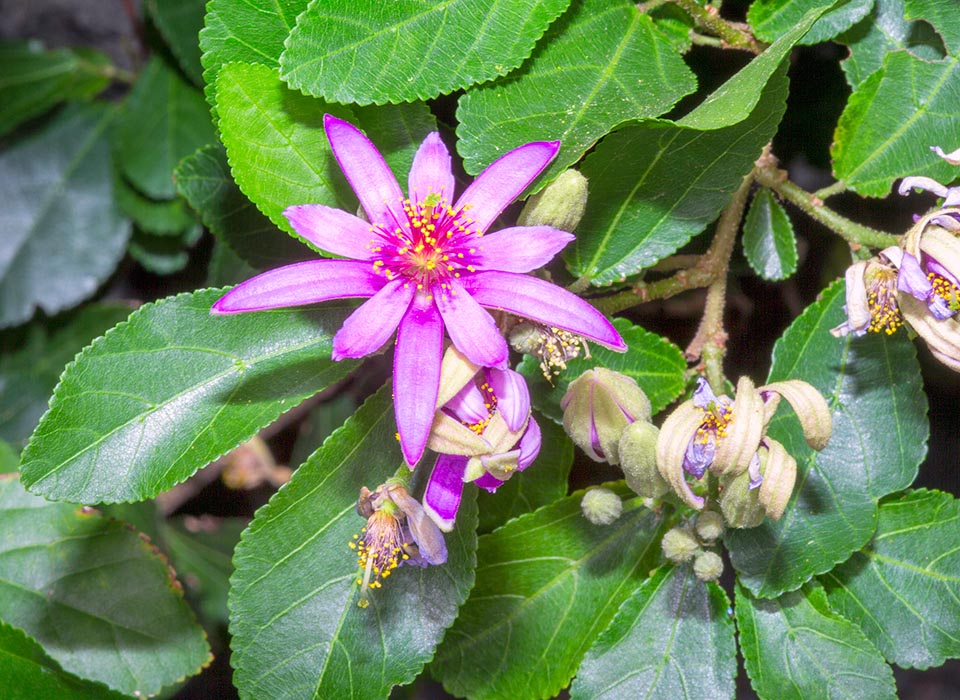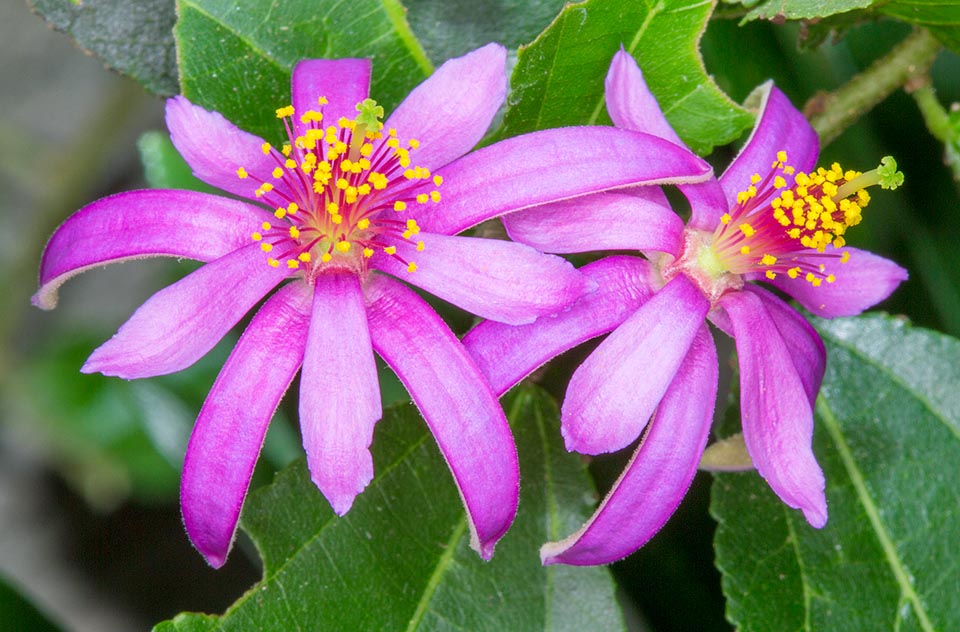Family : Malvaceae

Text © Pietro Puccio

English translation by Mario Beltramini
The species is native to Mozambique, South Africa and Zimbabwe where it grows in environments very different from each other, from the forests and thickets near water streams to semi-arid zones (karoo) on sandy or rocky soils, from the sea level up to about 1500 m of altitude.
The genus is honoured to the English physician and botanist Nehemiah Grew (1641-1712), author of “The Anatomy of Plants” (1682); the name of the species is the Latin adjective “occidentalis, e” = western, given by Linnaeus to distinguish it from the Grewia orientalis L. native, according to the knowledge of the time, to India.
Common names: assegai wood, bow-wood, buttonwood, cross-berry, four-corners, lavender star flower, star-flower (English); assegaaibos, booghout, iLalangathi, iKlolo, iManhlele, mogwana, kruisbessieboom, mokukutu, mulembu, muMaka, umSipane, Nsihana, rosyntjiebos (South Africa).
The Grewia occidentalis L. (1753) is a woody evergreen or deciduous shrub, in less favourable climates, up to about 3 m tall, with tendentially prostrate branches, initially brown-reddish and pubescent, then greyish and glabrous.
The leaves, on a 0,5-2 cm long petiole, are alternate, simple, ovate to ovate-lanceolate with obtuse or acute apex and crenate-serrate margin, 3-7 cm long and 2-4 cm broad, of olive green colour, semi glossy.

Native to Mozambique, South Africa and Zimbabwe, Grewia occidentalis is a shrub, evergreen or deciduous depending the climate, reaching 3 m of height © Giuseppe Mazza
Inflorescences, on a 1-1,4 cm long peduncle, axillar, cymose, bearing few flowers, on an up to about 1 cm long pubescent pedicel, of pink, lavender or purple, rarely white, colour, of about 3 cm of diameter. Calyx with 5 linear-lanceolate sepals with acute apex, externally white-greenish, of the same colour as the petals inside, about 1,5 cm long, 5 oblong-linear petals, about 1,3 cm long, numerous stamens of the same colour with yellow anthers, quadrilobed ovary and style, about 1 cm long, with quadrilobed stigma.
The flowers are hermaphrodite, but proterandrous (the male organs ripen before the female ones), this prevents the self-pollination that must be necessarily crossed.
The fruit is a quadrilobed drupe of reddish brown colour when ripe, of 2-4 cm of diameter, persistent for long time on the plant. The fruits are in important source of food for the fauna that contributes to the dispersion of the seeds, that germinate more easily after the passage through the digestive system of the animals who eat them.
It reproduces, by seed previously kept in water for two days, in draining loam, aerated, maintained humid at the temperature of 24-28 °C, with germination times of 2-6 weeks, and also by cutting, offshoot and layering.
Decorative shrub of long blooming, of easy cultivation and averagely fast growth, utilizable, due to the remarkable flexibility of the branches, as soil cover, as procumbent or to cover espaliers, bears the pruning, even if drastic, it is possible then to realize small trees, borders, fences, formal and informal, and proves particularly suitable for the topiary art and for the realization of bonsai.

Long blooming. It bears the topiary art drastic pruning and the life as bonsai. Resistant and flexible wood. Medicinal virtues © Giuseppe Mazza
Cultivable in the tropical, subtropical and warm temperate climate regions, where it can stand temperatures up to about -5 °C for short time, but with damage to the foliage starting from the -2/-3 °C, in full sun or at maximum slightly shady and adapts to an ample variety of soils, provided draining; it can bear periods of drought, but grows luxuriant if regularly irrigated in the climates having long warm and dry summers.
It grows well also in pot, for the decoration of open spaces and eventually for being sheltered in winter in particularly luminous environment, with lowest temperatures not under the 10 °C, utilizing a fertile loam with coarse sand or agri-perlite for a best drainage. Regular and abundant watering during the growth, but without stagnations, more spaced in winter in way to allow the upper layer of the loam to dry up, and monthly fertilizations, in spring summer, with a hydrosoluble product balanced at half the dosage suggested.
The fruits are edible and are locally consumed raw or under form of juice; from them, after fermentation, they get an alcoholic drink. The wood, particularly resistant and flexible, easy to work at the lathe, is utilized for small handicrafts and by some tribes for making spears and bows for arrows. Various parts of the plant are utilized since remote times in the traditional medicine for various pathologies, besides for magic rituals.
Synonyms: Grewia ulmifolia Salisb. (1796); Grewia obtusifolia Eckl. & Zeyh. (1834); Grewia trinervis E.Mey. (1843); Grewia chirindae Baker f. (1911); Grewia microphylla Weim. (1936).
→ To appreciate the biodiversity within the MALVACEAE family please click here.
